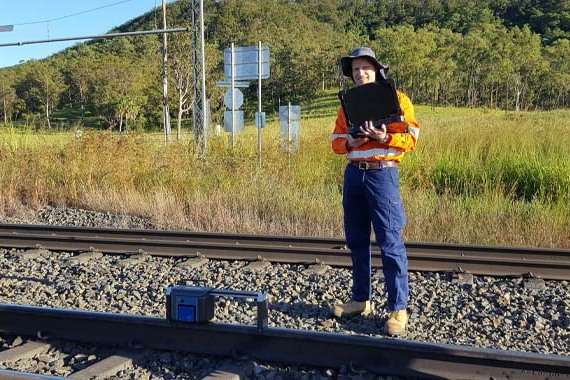Virtual Simulations on Track to Improve Rail and Rollingstock Life Cycles
Description
This project focuses on identifying sections of track that are at a high risk of damage through the implementation of digital twin techniques, a virtual simulation of real trains and track conditions.
Impact
Railway operators now have a better understanding of track and wheel wear with this new technology. It will assist them in making informed decisions when it comes to rolling stock and tracking operational limits while maximising the performance that the materials can offer and reducing maintenance actions.
Professor Maksym Spiryagin
Maintenance activities on rails and rolling stock wheels are the main contributors to the cost of operating railway networks. The current wear rate measurements are costly, time-consuming and not always practical.
CQUniversity's Deputy Director of the Centre for Railway Engineering (CRE), Professor Maksym Spiryagin's research project focuses on identifying sections of track that are at a high risk of damage through the implementation of digital twin techniques.
The digital twin platform pairs the virtual and physical worlds by using different techniques to replicate train behaviour in a digital world with a high level of accuracy. It provides a comprehensive understanding of wheel and track wear and the service life cycle of Australian rail materials under various conditions.
Professor Spiryagin's research is focused on the complexities of the rail vehicle/track nonlinear interaction and the wear and damage that this causes on the wheel and the track components. The digital twin platform has allowed him to create a simulation of real trains and track conditions to perform testing under different operational scenarios without the risk of being in the railway corridor or disrupting the network.
'Such an approach avoids any limitations connected with the costs of experimental programs, including interruption of train operational services,' he says.
'For example, a one-day interruption on a heavy haul railway corridor can cost an iron ore company tens of millions of dollars.'
As the wheel-rail interface is subject to environmental and operational conditions such as surface contaminants, lubrication and roughness, performing field testing can vary the results significantly.
The simulation set involves variations in traction, friction conditions, track irregularities, wheel-rail profiles, track layouts and vehicle type, among other parameters.
CQUniversity's High-Performance Computing (HPC) facilities have allowed for accelerated simulation and result in analysis processing.
Previous industry research projects run by the CRE team have been focused on rail wear and fatigue crack initiation and propagation, known as rolling contact fatigue (RCF).
An experimental program was conducted in Central Western Australia, the Pilbara and Victoria by the CRE team. This involved complex field measurements being performed for rail surface friction characterisation at different track locations, which improved the accuracy of their analyses.
In the CRE laboratory, the specially designed wear testing machine is used to prove theoretical knowledge and behaviour observed in the field with a particular focus on rail wear and fatigue crack initiation and propagation and to find details that cannot be obtained from the field measurements.
The research studies performed by Professor Spiryagin are supported by the research and technical team of Dr Qing Wu, Professor Colin Cole, Adjunct Professor Peter Wolfs, Mr Esteban Bernal Arango, Dr Shah Nafis Ahmad, Dr Yan Sun, Dr Sundar Shrestha, Adjunct Research Fellow Tim McSweeney, Mr Chris Bosomworth, Mr Ben Sneath and Mr Randall Stock.
In the lead-up to the development of this new technology, Professor Spiryagin led multiple projects, all contributing to identifying the numerous causes of rail damage. His previous and current projects funded by the Australasian Centre for Rail Innovation and its industry partners include studying and analysing the impacts that different locomotive designs and heavy haul rollingstock had on the tracks and developing new analysis tools and techniques to analyse his findings.
As a world-class expert in his field, Professor Spiryagin takes the lead on all industry-related projects and is heavily involved in locomotive traction, contact mechanics and rail vehicle dynamics and mechatronics research activities. This research, however, has required multi-disciplinary knowledge to cover such complex systems.
These research outcomes relied on the software development and implementation support obtained from Ingemar Persson (AB DEsolver, Sweden), Dr.ir. Edwin A.H. Vollebregt (CMCC, The Netherlands), Mark Hayman (Insyte Solutions, Australia), and Jason Bell (HPC, CQUniversity).
Professor Spiryagin and the CRE team are delivering accurate results with this new technology which will assist railway operators in making informed decisions on rollingstock operational limits and maintenance actions. This will promote good wheel and rail health while maximising the performance that the materials can offer.
Professor Spiryagin says that increasing the knowledge of operational and maintenance requirements for the wheel-to-rail interface will deliver greater rail operation efficiencies.
Connect with CQUniversity
At CQUniversity we know the value of our connections locally and around the world. Our partnerships help us create opportunities, deliver solutions and change lives. From time to time, we share our Connections Count update, where we share our highlights, including research impact stories like the ones below. Sign up to become one of our valued connections.

